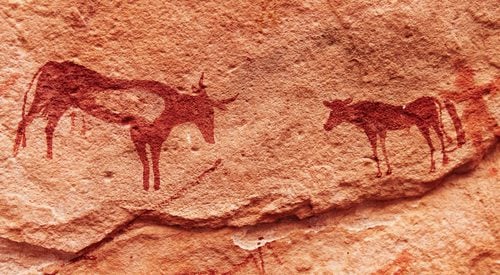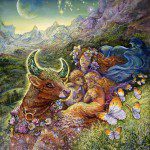
Were early hunter-gatherer peoples naturalistic? It is difficult to tell. They were every bit as intelligent and creative as us, and could have created the first naturalistic traditions. Some may even reason that before the first notions of gods and spirits were invented, people must have been naturalistic. Evidence suggests otherwise, however.
This post is part of Naturalistic Traditions, a column exploring naturalism in Pagan ways. The present series explores the historical roots of naturalistic ways in order to gain an expanded sense of the historicity of the diverse styles of belief common in Paganism today.
The possibility of early naturalism
Tantalyzing evidence points to the possibility of naturalism* among our earliest human ancestors.
1. Doubters and dabblers
First, ethnographic studies suggest that a certain percentage of a population tends to be disinterested in the majority religion. Study of contemporary hunter-gatherer societies** by Brian Hayden reveals:
about ten percent of the people simply did not care about rituals or supernatural beliefs, while another ten to twenty percent had abandoned their traditional beliefs… and most… did not have a working knowledge of their own religious doctrines of myths, even though these were accessible. (Hayden, 2003, quoted in Haule, 2011, p. 206-207)
If that pattern maintained also among ancient hunter-gatherers, a significant minority may have been doubtful or indifferent toward majority interpretations, including divine and magical explanations of phenomena.
In some cases, even the majority may have lacked belief in such things: the work of anthropologist Mary Douglas (1970) reveals that not all tribal societies are equally enthralled by magic and ritual. Majorities in some cultures and minorities in all cultures may have been doubtful or indifferent toward divine and magical explanations.
Nevertheless, we must not conflate doubt and indifference with naturalism. The former is an attitude toward views not held, the latter a particular worldview. It takes significantly more than disbelief to constitute naturalism.
2. Ritualized behavior before rationale
Second, early human ritual may have emerged long before any linguistic rationale involving gods or spirits. Early funerary practices such as burials with red ochre or grave goods, usually taken to indicate belief in an afterlife, need not be interpreted so. Burial could be a ritualized behavior requiring no conceptual rationale at all.***
This position gains some credence from the fact that other hominids display ritualized behaviors in the absence of symbolic communication (i.e. language). Jane Goodall (1975), for example, points to chimpanzee threat displays in the presence of thunderstorms and waterfalls, and suggests it may indicate the “awe and wonder, that underlie most religions.” If the comparison is valid, it would indicate that at least some ritualized behaviors need no conceptual rationale.
Nevertheless, the absence of symbolic communication strikes down a naturalistic worldview as quickly as any other, since naturalism itself is a kind of rationale. Furthermore, Guthrie (1993) points out that chimpanzees may be unconsciously anthropomorphizing the storm as a threatening creature, and attempting to frighten it off by their displays. In that light, the evidence could suggest early notions of proto-gods or proto-spirits as easily as an awe for impersonal nature.
In sum, the evidence for ritualized behavior prior to divine and magical rationales may be intriguing, but fails to support naturalism as a worldview.
3. Experiential religion
Many modern tribal religions seem to be more experiential than doctrinal in nature. Take the Kalapalo of Brazil****, for example:
Musical performance is associated with powerful beings and is a means of communicating with them although it is not directly addressed to them . . . Communication may be said to occur not by singing to a powerful being but by singing it into being. (Basso, 1985, quoted in Bellah, 2011)
This singing-into-being sounds more like a psychological experience than a metaphysical doctrine. If so, it would align well with ways many Naturalistic Pagans view deities.
However, we must be careful not to project our own psychological explanations onto other peoples. Cultures like the Kalapalo may still consider their powerful beings to have a separate ontological existence even if it is only realized by singing-into-being, much like Platonic forms. Or, more likely, they simply may not consider the question of ontological status particularly relevant, and think nothing special about it. The experiential nature of many tribal religions might suggest something about our early ancestors, but if so it doesn’t necessarily entail naturalism as a worldview.
4. Myths of a single nature with nothing standing outside it
Finally, the myths of known hunter-gatherer cultures offer intriguing possibilities. One trait of the naturalistic worldview is shared by many early mythologies the world over: the concept of the world as of a piece. I do not mean philosophical monism, but simply the idea that the cosmos and everything in it developed with no outside influence, no super-natural deity standing outside it. Many early mythologies depict gods giving the current shape to a world already in existence. A common example is the earth-diver myth found in variations across Europe, Asia, and North America, where a creator bids a prehuman animal dive into primeval waters to bring up the earth from the depths (Leeming, 2009). There is a creator deity, but it only gives new order to a prior world of which the creator is itself a part.
A number of important caveats must be made here. First, it may be wise not to over-emphasize origins in linear time in early peoples; these “beginnings” may speak more of cyclical time, or a realm outside time such as the Dreaming of Australian aboriginal tribes (Bellah, 2011). Second, just because these stories do not depict a creator outside of nature does not necessarily mean they reject the idea; indeed, the significance we now see in a deity within nature, as opposed to one outside it, is likely an artifact of our perspective, and may not have been especially salient to early peoples. Finally, if the concept of the world as of a piece can be counted among the roots of naturalism, it can also be counted among the roots of other views; most hard and soft polytheist views portray deities as part of a pre-existing nature. It is how the concept develops in later cultures and interacts with other naturalistic traits that matters; the concept alone does not indicate naturalism.
Given these lines of evidence, it remains an intriguing possibility that something like naturalism could have been emerging among early hunter-gatherers, even if incipient and inchoate. However, other evidence, especially that deriving from universal human cognition, suggests that may be unlikely.
The improbability of early naturalism
Cognitive psychologists have discovered much about the intuitive ontologies and biases inherent to all human minds. Infants and young children, long before they are taught, seem to already know certain things about how the world works. Studies show they know solid objects can’t pass through each other, for example (Baillargeon, et al., 1995), and that piglets are not born from ponies (Tooby & Cosmides, 1992). Certain aspects of this universal human cognition imply that the default intuitive worldview of homo sapiens may not involve a nature characterized by impersonal physical laws.
1. Anthropomorphic tendencies
First, an impersonal nature seems to go against the universal human penchant for anthropomorphism. Guthrie (1993) shows the pervasiveness of this tendency, and explains its persistence in evolutionary terms. A rustle in the reeds may be a predator. If it isn’t, it hardly hurts to think it is. But if it is a predator and you ignore it, you’re lunch. Seeing agents all over the place evolved as a “good bet”, even if it is not always factually accurate. On an even more basic level, we’re tuned to pay attention to what matters most to survival and reproduction, and for our species what matters most is other people. Thus, we see faces in the clouds, and infer agency everywhere in nature. This tendency implies the likelihood of the perception of a personal nature, pervaded perhaps by something like gods and spirits, even in our earliest ancestors.
2. Dualist tendencies
Second, an exclusively physical nature appears to contradict our intuitive dualism. Jesse Bering (2006) has studied the folk psychology of souls, and found the sense of separateness between mind and body to be a cognitive default. We are intuitive dualists. That makes a cosmology allowing for disembodied minds, be they souls or deities, likely to emerge among early peoples.
3. Order-chaos tendencies
Finally, a nature based on orderly laws is not to be taken for granted. Surely all thought and planning relies on a certain level of predictability in nature on the surface level, but it is not required that nature be so on a fundamental level. Contrary views, where nature is not inherently ordered but must be put in order, are common. The traditional Indian cosmos has been described as “made, not given”: ritual action is required to keep the order going (Bellah, 2011). A similar idea can be glimpsed in the common Neopagan practice of singing back the sun on the winter solstice, as if it might not return otherwise.***** Such views pervade many world mythologies. To my knowledge, there has been no investigation into the cognitive foundations of a potentially chaotic universe, but the ethnographic evidence at least suggests an orderly nature is not necessarily obvious. Perhaps it arises more by analogy to orderly, law-based government than by default intuition, in which case early hunter-gatherers probably would have drawn no such analogy.
Thus, a nature characterized by impersonal physical laws does not seem especially facilitated by universal human cognition, and may perhaps go against it. Culture can and does often contradict intuition, of course, but only with great effort, and intuitive cognition always continues to exert an influence. With this in mind, naturalism appears not only unlikely in early hunter-gatherers, but also delicate and difficult to maintain in any human population. The environmental and cultural conditions supporting naturalism in the modern age should not be taken for granted.
So, were early hunter-gatherers naturalistic?
Given the challenges faced by evidence for the possibility of early naturalism, combined with aspects of universal human cognition, there is no good reason to suggest that an incipient worldview akin to naturalism would have emerged earlier than other views conducive to gods, spirits, magic, and so forth. Rather, the evidence suggests the opposite.
Thus, it makes the most sense to conclude that naturalism was probably not a feature of early hunter-gatherer peoples. More likely, it had to wait for later ages.
*Here, as in the rest of this series, we are using naturalism to refer to a particular worldview, namely “the system of those who find all primary causes in nature” (Furst and Skrine, 1971). Furthermore, we must recognize that understandings of nature differ greatly across cultures, so we need to further characterize naturalism’s nature as operating according to impersonal physical laws (see previous posts for details).
**Similar environmental conditions often breed similar cultural responses, such that modern hunter-gatherer cultures might give us a clue to our early ancestors. However, the analogy should not be over-emphasized. Hunter-gatherer cultures are not monolithic; they are as varied as any other. Nor do modern ones necessarily reflect accurately what early ones may have been like. Thus, evidence from modern hunter-gatherers will be considered but held lightly in the following discussion, relying more on aspects of universal human cognition.
***Despite this possibility, the afterlife theory remains the most likely explanation for burial with red ochre and grave goods, in my estimation.
****The Kalapalo are actually horticulturalists, not hunter-gatherers, but the point stands.
*****Graham Harvey (1997) quotes a slightly more nuanced view presented by author Terry Pratchett (1996), whose novels are popular with Neopagans:
WHAT WOULD HAVE HAPPENED IF YOU HADN’T SAVED HIM?
“Yes! The sun would have risen just the same, yes?”
NO.
“Oh, come on. You can’t expect me to believe that. It’s an astronomical fact.”
THE SUN WOULD NOT HAVE RISEN.
…
“Really? Then what would have happened, pray?”
A MERE BALL OF FLAMING GAS WOULD HAVE ILLUMINATED THE WORLD. (Pratchett, 1996)
References
Baillargeon, R., Kotovsky, L., and Needham, A. (1995). “The acquisition of physical knowledge in infancy.” In Causal cognition: A multidisciplinary debate, edited by Sperber, D., Premack, D., and James-Premack, A., Oxford: Clarendon Press.
Basso, E. B. (1985). A Musical View of the Universe: Kalapalo Myth and Ritual Performances. Philadelphia: University of Pennsylvania Press.
Bellah, R. N. (2011). Religion in Human Evolution: From the Paleolithic to the Axial Age. Cambridge: Belknap Press.
Bering, J. (2006). “The Folk Psychology of Souls.” Behavioral and Brain Sciences (29), pp. 453–498.
Douglas, M. (1970). Natural Symbols: Explorations in Cosmology. London: Barrie & Rockliff.
Furst, L. and Skrine, P. (1971). Naturalism. London: Methuen.
Goodall, J. (1975). “The Chimpanzee.” In The Quest for Man, Goodall, V., ed., New York: Praeger.
Guthrie, S. (1993). Faces in the Clouds: A New Theory of Religion. Oxford: Oxford University Press.
Harvey, G. (1997). Contemporary Paganism: Listening People, Speaking Earth. New York: New York University Press.
Haule, J. R. (2011). Jung in the 21st Century, Volume One: Evolution and Archetype. New York: Routledge.
Hayden, B. (2003). Shamans, Sorcerors, and Saints: A Prehistory of Religion. Washington, D.C.: Smithsonian Books.
Leeming, D. (2009). The Oxford Companion to World Mythology. Oxford: Oxford University Press.
Pratchett, T. (1996). The Hogfather. New York: HarperCollins.
Tooby, J., and Cosmides, L. (1992). “The Psychological Foundations of Culture.” In The Adapted Mind, edited by Barkow, J., Cosmides, L., and Tooby, J., New York: Oxford University Press.

















